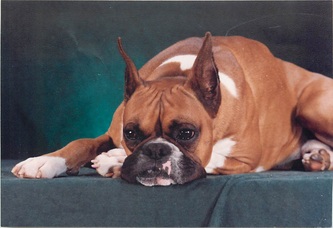MARKINGS IN BOXERS
What is the difference between a genetically "Plain or Classic" boxer, a white boxer, and a "Flashy" boxer?
First, it is important to understand how white is inherited in boxers. This is an excellent treates on the inheritance of white in boxers. Please read this first:
First, it is important to understand how white is inherited in boxers. This is an excellent treates on the inheritance of white in boxers. Please read this first:
There is an interesting theory by Dr. Garton that inheritance of white in show boxer populations may be different from that in pet populations. It is understood that breeding a genetically white boxer to a genetically classic or plain boxer will produce only 100% flashy puppies. Although breeding of white boxers is not allowed in the American Boxer Club Code of Ethics at this point in time, it has occasionally been done. There have been exceptions to this rule in pet populations, however. Please read this for more information:
Genetically Flashy vs. Genetically Plain or Classic:
Typically a plain/classic boxer is identified as one with little to no white on the face, no white above the toes and only a small amount of white on the chest. However, the marking pattern is affected by modifiers, so that a flashy Boxer, while genetically the same as another flashy Boxer, will not be phenotypically the same - one may have a full white collar, the other may only have white "stockings" and no white on the neck. Also, genetically plain Boxers do have a minimal amount of white markings on the toes, chest and belly. Because of the modifiers, a genetically flashy Boxer that is modified to have only a small amount of white markings may look phenotypically identical to a genetically plain Boxer. The only way to know for sure is to breed the dog understanding fully the genetic inheritance of white markings. A genetically plain/classic boxer bred to a genetically flashy boxer will not throw any white puppies.
More information on the genetics of coat color inheritance in boxers:
Brindle is a dominant color in boxers. Fawn is a recessive color. This means that if you breed fawn to fawn, you get 100% fawn puppies. If you breed Brindle, you need to know the genotype of that dog - does he/she have a fawn allele to contribute to a breeding? If the Brindle dog has a fawn parent, the answer is automatically YES. If the Brindle dog has a Brindle parent, you need to breed them to a fawn dog to find out what their genotype is. There is no gene test for coat color at this time.
If you wish to review the simple genetics that are understood about coat color inheritance such as fawn vs. brindle, this is an excellent page that shows dominance vs. recessive alleles in coat colors:
If you wish to review the simple genetics that are understood about coat color inheritance such as fawn vs. brindle, this is an excellent page that shows dominance vs. recessive alleles in coat colors:




